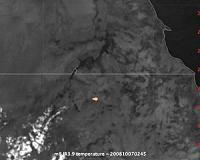 |
Washington DC (SPX) Dec 21, 2010 An international team of scientists studying remnants of an asteroid that crashed into the Nubian Desert in October 2008 discovered it contained at least 10 different types of meteorites. Some of them contained chemicals that form the building blocks of life on Earth, and those chemicals were spread through all parts of the asteroid by collisions. Chemists at Stanford University found that different meteorite types share the same distinct fingerprint of polycyclic aromatic hydrocarbons (PAHs). These complex organic molecules are distributed throughout the galaxy and form on Earth from incomplete combustion. A research team from NASA's Goddard Space Flight Center in Greenbelt, Md., found amino acids in strongly heated fragments of the asteroid, where all such molecules should have been destroyed. Both PAHs and amino acids are considered building blocks of life. Before landing on Earth, the 13-foot asteroid was detected by a telescope from the NASA-sponsored Catalina Sky Survey based at the University of Arizona in Tucson. Hours prior to its demise, astronomers and scientists around the world tracked and scanned the asteroid. It was the first time a celestial object was observed prior to entering Earth's atmosphere. NASA's Jet Propulsion Laboratory in Pasadena, Calif., created a search grid and impact target area. The data helped Peter Jenniskens, an astronomer at NASA's Ames Research Center in Moffett Field, Calif., and the SETI Institute of Mountain View, Calif., guide a recovery team from the University of Khartoum in Sudan to search the desert landscape. During four expeditions, approximately 150 students recovered nearly 600 meteorite fragments weighing a total of more than 23 pounds. "Right from the start, the students were surprised to find so much diversity in meteorite texture and hue," said Muawia Shaddad, an astronomer at the University of Khartoum, who led the search effort. "We estimate the asteroid initially weighed about 59 tons, of which about 86 pounds survived the explosion high in the atmosphere." Subsequently, scientists determined most of the fragments are a rare type of meteorite called ureilites. Less than 10 of the nearly 1,000 known meteorites are ureilites. The recovery team made history when they found the first-ever freshly fallen mixed-composition, or polymict ureilite. The majority of the remaining fragments are similar to the more common types of meteorites called chondrites. Other Ames researchers showed the ureilite fragments contained widely varying amounts of the minerals called olivine and pyroxene. Carnegie Institute of Washington researchers found these minerals have the full range of oxygen atom signatures detected in previous ureilites. Scientists believe this is evidence all ureilites originated from the same source, called the ureilite parent body. Astronomers theorize the parent body experienced a giant collision approximately 4.5 billion years ago and caused iron-rich minerals to smelt into metallic iron. However, the olivine and pyroxene didn't melt, which allowed the oxygen atoms in them to stay in the same arrangement as when they first formed. Researchers at NASA's Johnson Space Center in Houston were able to deduce that much of the ureilite parent body was reduced to fragments measuring 30 to 300 feet during this giant collision. After the catastrophic collision, scientists believe the material that ended up making 2008 TC3 had a long history of violent collisions and impacts. These later collisions ground the fragments down into the smaller sand grain-sized pieces that gathered loosely together with many voids. Researchers believe the amino acids were delivered to 2008 TC3 during the later impacts, or formed directly from trapped gases as the asteroid cooled following the giant collision. Other non-ureilite types of meteorites also became part of the asteroid. To date, ten different meteorite types have been identified, accounting for 20-30 percent of the asteroid's recovered remains. "Asteroids have just become a lot more interesting," Jenniskens said. "We were surprised to find that not all of the meteorites we recovered were the same, even though we are certain they came from the same asteroid." Astronomers have known asteroids orbiting the sun frequently are broken and reassembled during collisions, but until now they thought little mixing occurred because asteroids, or impactors that broke them apart, are usually very small. The research is featured in 20 papers published this week in an issue of the Meteoritical Society's journal Meteoritics and Planetary Science.
Share This Article With Planet Earth
Related Links Goddard Space Flight Center Asteroid and Comet Mission News, Science and Technology
 Asteroid's Coat Of Many Colors
Asteroid's Coat Of Many ColorsPalo Alto CA (SPX) Dec 21, 2010 An international team of scientists studying remnants of an asteroid that crashed into the Nubian Desert in October 2008 discovered it contained at least 10 different types of meteorites. Some of them contained chemicals that form the building blocks of life on Earth, and those chemicals were spread through all parts of the asteroid by collisions. Chemists at Stanford University found that ... read more |
|
| The content herein, unless otherwise known to be public domain, are Copyright 1995-2010 - SpaceDaily. AFP and UPI Wire Stories are copyright Agence France-Presse and United Press International. ESA Portal Reports are copyright European Space Agency. All NASA sourced material is public domain. Additional copyrights may apply in whole or part to other bona fide parties. Advertising does not imply endorsement,agreement or approval of any opinions, statements or information provided by SpaceDaily on any Web page published or hosted by SpaceDaily. Privacy Statement |